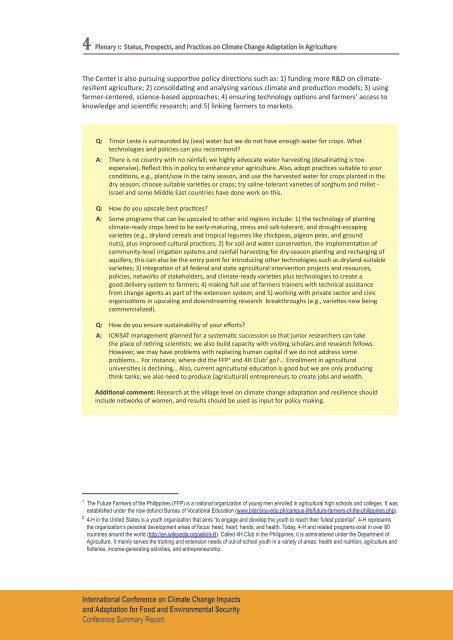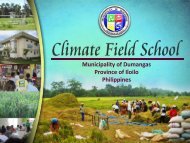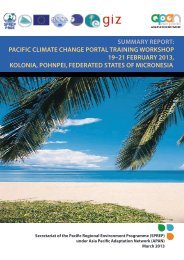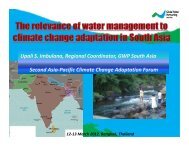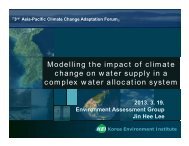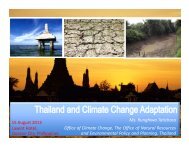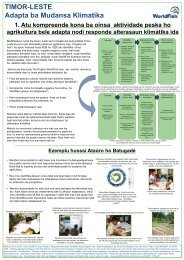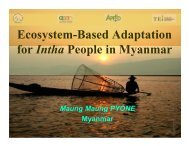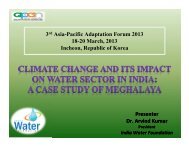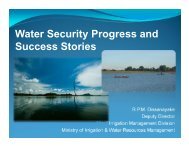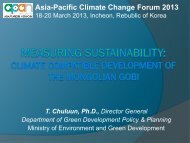PDF file (2.44 MB) - Asia Pacific Adaptation Network
PDF file (2.44 MB) - Asia Pacific Adaptation Network
PDF file (2.44 MB) - Asia Pacific Adaptation Network
You also want an ePaper? Increase the reach of your titles
YUMPU automatically turns print PDFs into web optimized ePapers that Google loves.
4Plenary 1: Status, Prospects, and Practices on Climate Change <strong>Adaptation</strong> in AgricultureThe Center is also pursuing supportive policy directions such as: 1) funding more R&D on climateresilientagriculture; 2) consolidating and analysing various climate and production models; 3) usingfarmer-centered, science-based approaches; 4) ensuring technology options and farmers’ access toknowledge and scientific research; and 5) linking farmers to markets.Q: Timor Leste is surrounded by (sea) water but we do not have enough water for crops. Whattechnologies and policies can you recommend?A: There is no country with no rainfall; we highly advocate water harvesting (desalinating is tooexpensive). Reflect this in policy to enhance your agriculture. Also, adopt practices suitable to yourconditions, e.g., plant/sow in the rainy season, and use the harvested water for crops planted in thedry season; choose suitable varieties or crops; try saline-tolerant varieties of sorghum and millet -Israel and some Middle East countries have done work on this.Q: How do you upscale best practices?A: Some programs that can be upscaled to other arid regions include: 1) the technology of plantingclimate-ready crops bred to be early-maturing, stress and salt-tolerant, and drought-escapingvarieties (e.g., dryland cereals and tropical legumes like chickpeas, pigeon peas, and groundnuts), plus improved cultural practices; 2) for soil and water conservation, the implementation ofcommunity-level irrigation systems and rainfall harvesting for dry-season planting and recharging ofaquifers; this can also be the entry point for introducing other technologies such as dryland-suitablevarieties; 3) integration of all federal and state agricultural intervention projects and resources,policies, networks of stakeholders, and climate-ready varieties plus technologies to create agood delivery system to farmers; 4) making full use of farmers trainers with technical assistancefrom change agents as part of the extension system; and 5) working with private sector and civicorganizations in upscaling and downstreaming research breakthroughs (e.g., varieties now beingcommercialized).Q: How do you ensure sustainability of your efforts?A: ICRISAT management planned for a systematic succession so that junior researchers can takethe place of retiring scientists; we also build capacity with visiting scholars and research fellows.However, we may have problems with replacing human capital if we do not address someproblems… For instance, where did the FFP 1 and 4H Club 2 go?... Enrollment in agriculturaluniversities is declining… Also, current agricultural education is good but we are only producingthink tanks; we also need to produce (agricultural) entrepreneurs to create jobs and wealth.Additional comment: Research at the village level on climate change adaptation and resilience shouldinclude networks of women, and results should be used as input for policy making.1 The Future Farmers of the Philippines (FFP) is a national organization of young men enrolled in agricultural high schools and colleges. It wasestablished under the now defunct Bureau of Vocational Education (www.bilar.bisu-edu.ph/campus-life/future-farmers-of-the-philippines.php).2 4-H in the United States is a youth organization that aims “to engage and develop the youth to reach their fullest potential”. 4-H representsthe organization’s personal development areas of focus: head, heart, hands, and health. Today, 4-H and related programs exist in over 80countries around the world (http://en.wikipedia.org/wiki/4-H). Called 4H Club in the Philippines, it is administered under the Department ofAgriculture. It mainly serves the training and extension needs of out-of-school youth in a variety of areas: health and nutrition, agriculture andfisheries, income-generating activities, and entrepreneurship.International Conference on Climate Change Impactsand <strong>Adaptation</strong> for Food and Environmental SecurityConference Summary Report


